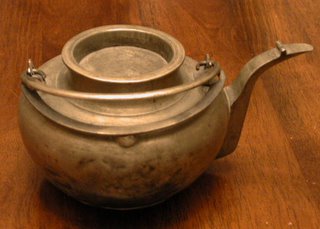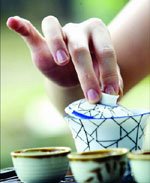
Here's an old Chinese kettle. Notice the spout of this kettle is also elongated and narrow. None of that funny wide-spout jug kettle business.
Sometimes just because it's new doesn't mean it's better.
This kettle has an interesting design. Notice the spout has a hinged cap on the end. I guess that's to prevent anything from getting into the kettle and contaminating the water.
Notice the knob on the side of the kettle. It's a handle rest. If you handled this kettle, you better be skillful - because it would be quite hot. So you need to have a towel to grasp the handle. And same thing with the lid. Use a towel to take the lid off to pour more water into the hot kettle.
This is such a lovely old kettle. I'm sure many people got a lot of pleasure out of making tea with this kettle in days gone by. Well, anyway, there is a thick caking of scale inside the kettle, so I'm sure it was used quite often.


4 comments:
What a wonderful kettle. It is interesting about the hinge. Do you think it might be to keep the heat inside if the whole kettle of water wasn't used? Just a thought. Very unique pot.
Not really to keep the heat inside. I think its meant to keep things out, to keep things from spoiling the water - like ash, smoke, or whatever.
Back in old China, they were very careful with the water they used for tea.
That is true. Amazing what a bit of ash can do to transform your tea! ;)
When I go camping in the summer, I bring along a porcelain teapot, some tea cups, a tetsubin, and some tea.
I have a metal grate that I can set the tetsubin on, over a fire.
But when you put the tetsubin on the rack over a fire, then, there is a lot of smoke - and ash.
The ash gets everywhere - in the teacups, in the teapot, in the kettle. So basically, like this, you can't avoid ash in your tea.
I guess the best thing is to use a lot of hardwood, and burn it up until it gets to red hot coals. Then, use a grate that is low enough to the coals to heat the water. Then, continuously fan the coals so little smoke is produced.
Then, wait until the water boils. That could take a long time. You have to be patient.
Post a Comment